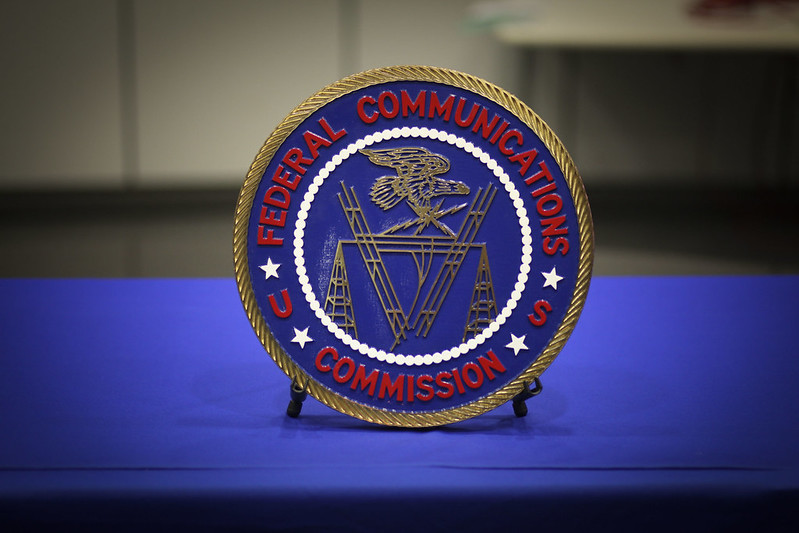Latest News

Federal Communications Commission seal. Photo: Creative Commons license/jeanbaptisteparis via Flickr
On September 25, Anna Gomez (a Wiley alum) was sworn-in as the FCC’s fifth Commissioner. Commissioner Gomez is a Democrat and joins fellow Democrats Jessica Rosenworcel (Chairwoman) and Geoffrey Starks along with Republicans Brendan Carr (also a Wiley alum) and Nathan Simington. By statute, the FCC is to have five Commissioners — two from the minority party in Congress and three representing the majority party. Since President Biden took office on January 20, 2021, however, the FCC has had only four Commissioners, with two on each side. Without a tie-breaking vote, the FCC has remained stalemated on more controversial matters, such as net neutrality.
What does a fifth Commissioner mean for the space industry? Maybe less than other communications sectors, actually. Since January 2021, the Commission has voted on nine space-related items at its monthly “open meetings,” each of which received unanimous support from all four Commissioners. There seems to be broad consensus that the space industry is growing at a rapid pace and that regulations should adapt accordingly. As Commissioner Rosenworcel recently noted, “the new space age needs new rules.”
With that said, what might be the more contentious or complicated issues we’ll see come before the full five-member Commission? One potentially substantial area of rule-making still in its nascency is an effort by the FCC to identify what role, if any, it should play in extra-orbital space operations. The Commission previewed this interest in a recent Notice of Inquiry in which it sought comment about the FCC’s role in planetary protection and how it might oversee commercial activities occurring outside of Earth’s orbit that communicate with FCC-licensed terminals on the ground. Here are some other areas we’ll be watching:
Orbital Debris: The Commission completed a comprehensive update of its orbital debris rules in 2020. Among other rule changes, the agency adopted new disclosure requirements for Non-Geostationary Orbit (NGSO) systems and new collision and disposal reliability metrics. At the same time, the Commission declined to adopt orbital separation requirements for large NGSO systems because such concerns would “be best addressed . . . through inter-operator coordination.”
This move prompted some satellite operators to petition the FCC to reconsider its decision after a handful of operators submitted applications for NGSO systems with overlapping orbits. Although the FCC released a new round of rules in 2022 to shorten the post-mission disposal period for missions ending in and transiting through Low-Earth Orbit (LEO), the Commission has not yet addressed other orbital debris issues implicated by increased crowding in LEO. Proposed solutions to some of these issues include rules to indemnify the United States against claims for damage caused by a licensee’s satellite operations and requiring licensees to post an additional surety bond to be returned following successful post-mission disposal of spacecraft.
ISAM: In August 2022, the FCC released a Notice of Inquiry seeking comment on how best to support future In-space Servicing, Assembly, and Manufacturing (ISAM) development, innovation, and operations. The FCC has acknowledged that “ISAM activities may raise new opportunities and challenges for the sustainability of the outer space environment and the space-based services on which the United States government, businesses, and individuals rely on every day to communicate, navigate, and perform other vital functions. As these capabilities evolve, the norms, rules, and principles that guide outer space activities may also require renewed attention.”
Single Network Future: In March 2023, the FCC released a Notice of Proposed Rulemaking asking for input on a new regulatory framework that would allow satellite operators collaborating with terrestrial service providers to obtain Commission authorization to communicate with space stations on spectrum allocated to terrestrial services. The Commission characterizes its proposed framework—which would allow satellites to connect Americans using everyday phones when terrestrial service is unavailable—as having the potential to “enable innovation and investment in nascent satellite and terrestrial interoperable technologies” and allow “cross-industry stakeholder partnerships to flourish.” The five-member Commission may be keen to approve SNF technology that enables the provision of broadband connectivity to Americans in currently unserved areas.
Space Launch Activities: The Commission’s recently released Second Space Launch Order finalized new spectrum allocation rules allowing for space launch activities in the S-band (2200-2290 MHz) and included a Further Notice of Proposed Rulemaking to identify ways in which the FCC can further support the space launch industry. A future Third Space Launch Order may make additional frequency bands available for launch operations as well as new allocations and rules for sub-orbital spaceflight and other “space operations” including crewed missions that fall outside the scope of earlier rulemakings.
Space is once again a “hot topic” at the Commission, and industry stakeholders have the unique opportunity to participate in rulemaking proceedings to help shape the future of the U.S. space industry and how it is regulated. We look forward to continued action by the full Commission to advance U.S. leadership in space.
Jennifer Hindin is co-chair of Wiley’s Telecom, Media & Technology Practice and chair of the Space and Satellite Group. Henry Gola and Kathryne Dickerson are partners in our Space and Satellite Group, along with associate Jillian Quigley. Wiley’s team offers strategic counsel to clients in a variety of complex regulatory, transactional, litigation, and compliance matters in the areas of satellite, media, and telecommunications.
Get the latest Via Satellite news!
Subscribe Now